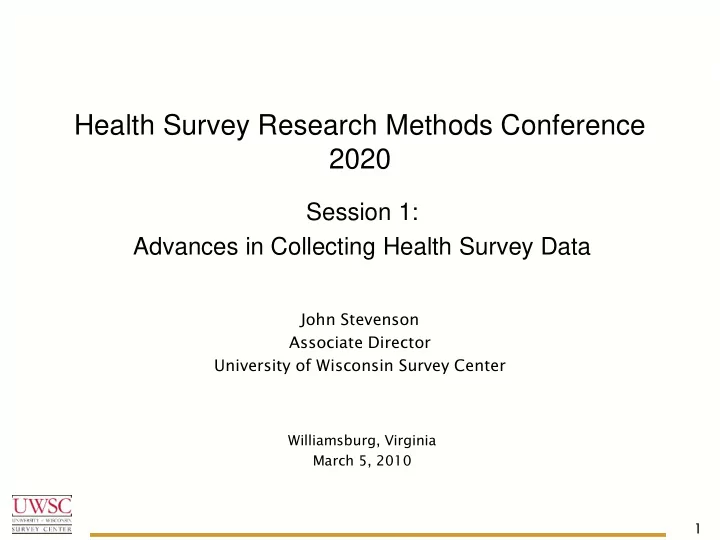

Health Survey Research Methods Conference 2020 Session 1: Advances in Collecting Health Survey Data John Stevenson Associate Director University of Wisconsin Survey Center Williamsburg, Virginia March 5, 2010 1
John Boyle: Propensity to Participate in Surveys with Physical Measures and Biomarker Collection: Potential Opportunities and Limitations • Rapid growth of the use of bio-measures requires we ensure good participation rates across populations and types of measures • How predictive are attitudes of behavior? • Mode impacts/increases participation: • In-home, onsite, clinic • Impact of interviewer: rapport, persuasion, refusal conversion • Use of incentives: overall &/or by measure • Comparisons to national gen pop studies? • Wisconsin Longitudinal Study (older, educated) • Height, weight, waist, hip, lung capacity, chair rise, hand grip strength, walking speed, photograph • Lowest level 89%, most 92-98% 2
Kirsten Becker: Examining the Effectiveness of Push-to-Web Mixed Mode Approaches on Response Rates in an Emergency Department Setting • Multi arm, multi-mode, multi-multi mode, multi-multi- multi mode…. In a complex/challenging setting • Mail phone still achieved highest response rates • Largest benefit to new modes • Cost (maybe) • Shortening time between event and measurement • Text increased reach of study, but how much did it increase rates? • Would enjoy hearing more about • Data quality concerns • Representation by arm • Cost analysis • Underscores the need for improving collection of contact info • Tailoring might include tailoring to types of contact info and permission to text 3
Martha Kovac: Conducting a Mixed-Mode Web and Telephone Survey with an Adult Population with Disabilities: Will a Web Survey Mode Improve Response and Data Quality? • Using web survey & related technology to make surveys more accessible • Those more likely to use web followed fairly predictable patterns • Curious about incentive design and its impact • Would like to know more about: • Overall response rates • Response rate by disability • Concerned about how little we do about this aspect of design: • More Information about techniques/designs to tailor in general.. • …and for different types of disabilities 4
David Dutwin: Methods and Considerations in Transitioning RDD to ABS: An Assessment of ABS Nonresponse Bias • Examination of studies different modes/frames as we transition from RDD to ABS • Plug: Transitions from Telephone Surveys to Self-Administered and Mixed-Mode Surveys • Issues relating to household vs. individual as unit of analysis • Effect of mode on who responds is non-trivial (age, education, race) • Interested in hearing more about: • Range of options people are trying for study designs varying modes, 1 vs 2 stage designs 5
Lots of time for: Q & A… John Stevenson jrsteve1@wisc.edu 6
Recommend
More recommend